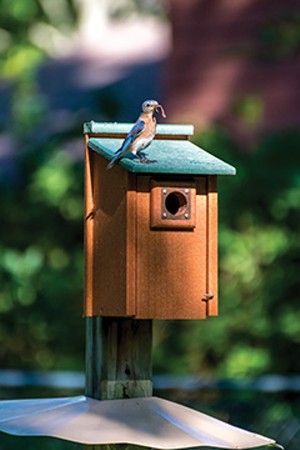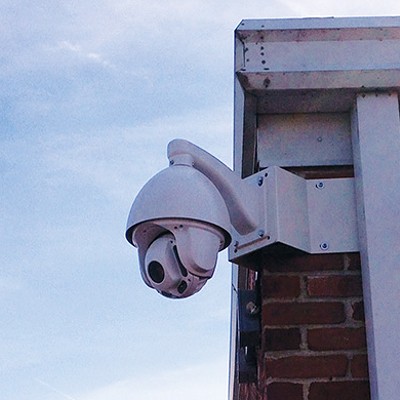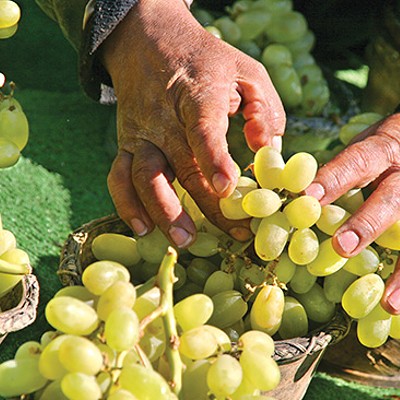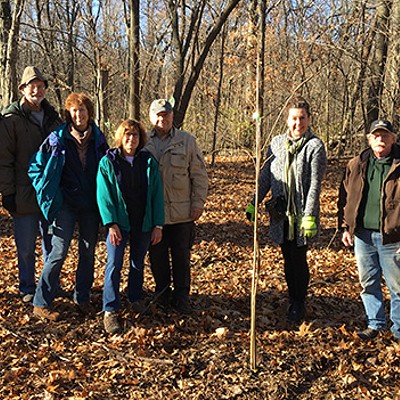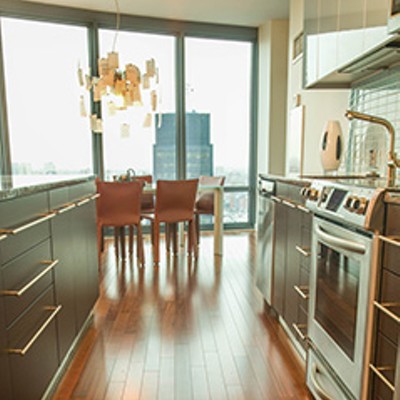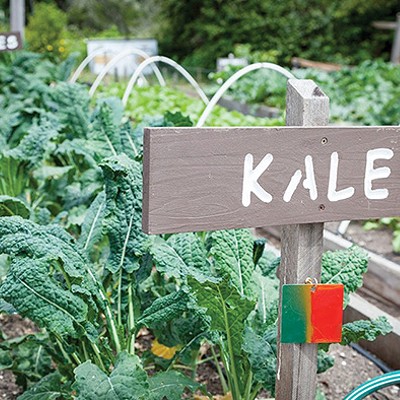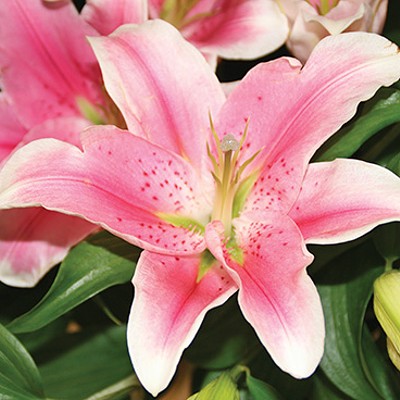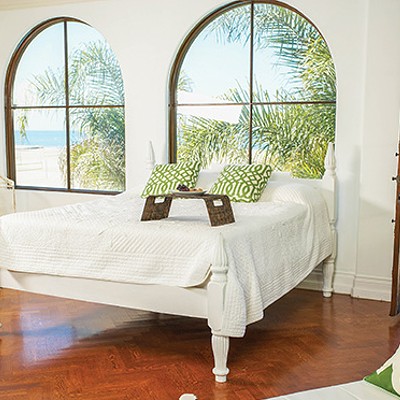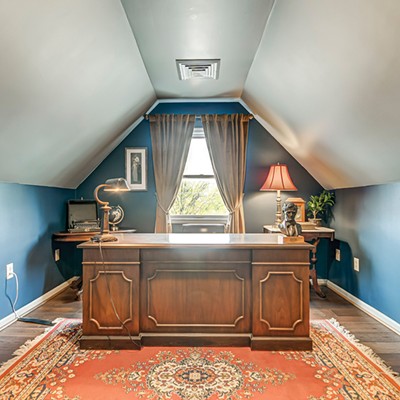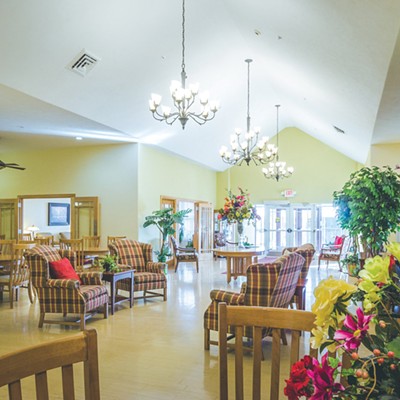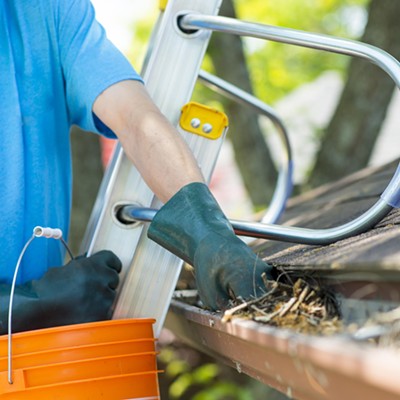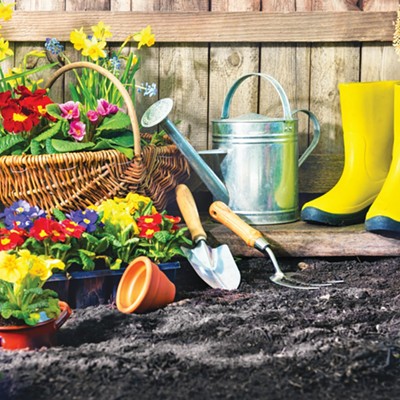Make your yard home to feathered friends
To build a better birdhouse, think like a bird
[
{
"name": "Air - MedRect Combo - Inline Content 1",
"component": "11490391",
"insertPoint": "3",
"requiredCountToDisplay": "1",
"parentWrapperClass": "fdn-ads-inline-content-block"
},{
"name": "Air - MedRect Combo - Inline Content 2",
"component": "11490392",
"insertPoint": "7",
"requiredCountToDisplay": "5",
"parentWrapperClass": "fdn-ads-inline-content-block"
},{
"name": "Air - MedRect Combo - Inline Content 3",
"component": "11490393",
"insertPoint": "12",
"requiredCountToDisplay": "9",
"parentWrapperClass": "fdn-ads-inline-content-block"
}
]
Early spring is a wonderful time to attract birds to your yard. Natural seed sources from last fall have been picked over and used up. Many of the insects that overwinter are still inactive. And it’s courtship and nesting time, which creates a high demand for fuel and housing. To make your yard a neighborhood favorite with residents and migrating visitors, keep filling the feeders and providing fresh water, says Wade Kammin, owner of Wild Birds Unlimited. And offer a variety of houses and materials to make your yard home.
Location, location, location
Place houses away from feeders, says Kammin. “No one likes to live next to the fast food restaurant.” Similarly, don’t put a birdhouse in a high-traffic walkway or driveway, by a frequently used door to your home or garage or near the neighbors’ noisy swimming pool or barking dogs. Find a quiet spot away from daily commotion.
Mount or hang your birdhouse securely to minimize swinging and any possibility of it falling, and where there is sufficient cover from weather and predators.
Susan Nelson’s and Rick Fiddyment’s Springfield home features large trees and woodland plants in front and in the sunny backyard prairie plants which attract several species of birds. The couple also provides food, water and three houses for wrens and chickadees. Two are in an area that faces, but is not near, their feeders and water sources, says Nelson, and one is fairly close to the front door. “But both of us work and there’s not a lot of coming and going from that door.”
Spring cleaning: birdhouse yes, yard not so much
Be sure to clean a birdhouse that’s been used as a shelter through the winter, and any time a family moves out during nesting season. Nelson says, “We do look inside carefully, especially if we see a parent leaving. Once the brood hatches and leaves, we empty out the nesting material and rinse the house with the hose.”
But don’t be too hasty to clean up winter yard debris. Dead trees and branches are prime locations for cavity dwellers. Birds also can chisel out chips for use in nest boxes. Dry grass, twigs, milkweed silk, catkins from cottonwoods and poplars, spider webs, moss and even snake skins provide excellent nesting material for young families, says the National Wildlife Federation at blog.nwf.org.
Single-family residence or condo complex?
Birds’ housing needs vary by species. Purple martins live in colonies. Robins and cardinals build cup nests on platforms, shelves and ledges not too far off the ground. Woodpeckers live in cavities they chip out of trees or in nest boxes you’ve jam-packed with wood chips that simulate trees. Select houses designed to accommodate the types of birds you want to watch.
In areas open enough to attract bluebirds, homeowners can join conservation efforts by providing houses with a single, small hole, easy-cling rough-surfaced wood panels inside and out, and a deep interior with a panel that opens for easy cleaning and viewing.
Many of the small songbirds common to Springfield neighborhoods are comfortable in a traditional square or rectangle house with a large, slanted roof and a single hole without a perch. The size of the hole and the distance from the hole to the floor inside will determine who moves in.
For example, according to a Wild Birds Unlimited nesting guide, chickadees and house wrens like to use an unpainted, natural wood (or recycled material) house with a 1-1/8-inch hole that accommodates their small size but not non-native sparrows, and grooves or rough surfaces on the inside walls to help babies climb out more easily. Panels that are ¾-inch thick provide insulation. Ventilation holes allow for climate control.
Home sweet home
In addition to grasses and twigs, natural fibers such as raw cotton twine and yarn cut into short lengths, and animal fur that hasn’t been flea treated, provide comfortable, water-repellent nests. Hang a loose ball of raw cotton wound with cotton twine and watch as finches pull tufts and fly to their nests.
Do not use dryer lint, synthetic fibers or human hair, says Kammin. Dryer lint tends to soak up water and may contain laundry chemicals; synthetic fibers and human hair can get tangled around birds’ legs and necks.
One handy way to provide nesting materials is to repurpose a suet feeder. “Cram a mix of the items into a suet feeder, giving songbirds access to a smorgasbord of building basics,” says the National Wildlife Federation blog. “Or, fill the head of a kitchen whisk with the various materials and hang the whisk by its handle from a tree or shrub.”
It can be helpful to create a false bottom of rabbit wire half an inch or so above the floor inside the nesting box. Lightly sprinkle diatomaceous earth (powdered siliceous sedimentary rock) under the wire to prevent insect infestation. Clean this out and resprinkle after the last babies leave each nest.
Familiar friends
Birds you fed and watered during the winter are more likely to stay and teach the next generation to feed and bathe in your yard if you provide safe, secure housing. Enjoy the sights and sounds as offspring become parents from year to year at your house.
DiAnne Crown is a frequent contributor for Illinois Times.
To view more of Matthew Chapman’s photos, visit https://www.flickr.com/photos/mec_stl and http://matthewchapman.net.
Location, location, location
Place houses away from feeders, says Kammin. “No one likes to live next to the fast food restaurant.” Similarly, don’t put a birdhouse in a high-traffic walkway or driveway, by a frequently used door to your home or garage or near the neighbors’ noisy swimming pool or barking dogs. Find a quiet spot away from daily commotion.
Mount or hang your birdhouse securely to minimize swinging and any possibility of it falling, and where there is sufficient cover from weather and predators.
Susan Nelson’s and Rick Fiddyment’s Springfield home features large trees and woodland plants in front and in the sunny backyard prairie plants which attract several species of birds. The couple also provides food, water and three houses for wrens and chickadees. Two are in an area that faces, but is not near, their feeders and water sources, says Nelson, and one is fairly close to the front door. “But both of us work and there’s not a lot of coming and going from that door.”
Spring cleaning: birdhouse yes, yard not so much
Be sure to clean a birdhouse that’s been used as a shelter through the winter, and any time a family moves out during nesting season. Nelson says, “We do look inside carefully, especially if we see a parent leaving. Once the brood hatches and leaves, we empty out the nesting material and rinse the house with the hose.”
But don’t be too hasty to clean up winter yard debris. Dead trees and branches are prime locations for cavity dwellers. Birds also can chisel out chips for use in nest boxes. Dry grass, twigs, milkweed silk, catkins from cottonwoods and poplars, spider webs, moss and even snake skins provide excellent nesting material for young families, says the National Wildlife Federation at blog.nwf.org.
Single-family residence or condo complex?
Birds’ housing needs vary by species. Purple martins live in colonies. Robins and cardinals build cup nests on platforms, shelves and ledges not too far off the ground. Woodpeckers live in cavities they chip out of trees or in nest boxes you’ve jam-packed with wood chips that simulate trees. Select houses designed to accommodate the types of birds you want to watch.
In areas open enough to attract bluebirds, homeowners can join conservation efforts by providing houses with a single, small hole, easy-cling rough-surfaced wood panels inside and out, and a deep interior with a panel that opens for easy cleaning and viewing.
Many of the small songbirds common to Springfield neighborhoods are comfortable in a traditional square or rectangle house with a large, slanted roof and a single hole without a perch. The size of the hole and the distance from the hole to the floor inside will determine who moves in.
For example, according to a Wild Birds Unlimited nesting guide, chickadees and house wrens like to use an unpainted, natural wood (or recycled material) house with a 1-1/8-inch hole that accommodates their small size but not non-native sparrows, and grooves or rough surfaces on the inside walls to help babies climb out more easily. Panels that are ¾-inch thick provide insulation. Ventilation holes allow for climate control.
Home sweet home
In addition to grasses and twigs, natural fibers such as raw cotton twine and yarn cut into short lengths, and animal fur that hasn’t been flea treated, provide comfortable, water-repellent nests. Hang a loose ball of raw cotton wound with cotton twine and watch as finches pull tufts and fly to their nests.
Do not use dryer lint, synthetic fibers or human hair, says Kammin. Dryer lint tends to soak up water and may contain laundry chemicals; synthetic fibers and human hair can get tangled around birds’ legs and necks.
One handy way to provide nesting materials is to repurpose a suet feeder. “Cram a mix of the items into a suet feeder, giving songbirds access to a smorgasbord of building basics,” says the National Wildlife Federation blog. “Or, fill the head of a kitchen whisk with the various materials and hang the whisk by its handle from a tree or shrub.”
It can be helpful to create a false bottom of rabbit wire half an inch or so above the floor inside the nesting box. Lightly sprinkle diatomaceous earth (powdered siliceous sedimentary rock) under the wire to prevent insect infestation. Clean this out and resprinkle after the last babies leave each nest.
Familiar friends
Birds you fed and watered during the winter are more likely to stay and teach the next generation to feed and bathe in your yard if you provide safe, secure housing. Enjoy the sights and sounds as offspring become parents from year to year at your house.
DiAnne Crown is a frequent contributor for Illinois Times.
To view more of Matthew Chapman’s photos, visit https://www.flickr.com/photos/mec_stl and http://matthewchapman.net.
Illinois Times has provided readers with independent journalism for almost 50 years, from news and politics to arts and culture.
Your support will help cover the costs of editorial content published each week. Without local news organizations, we would be less informed about the issues that affect our community..
Got something to say?
Send a letter to the editor and we'll publish your feedback in print!

